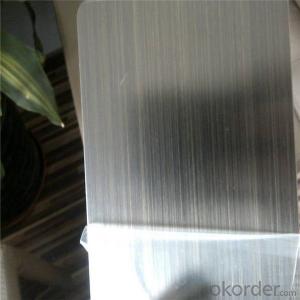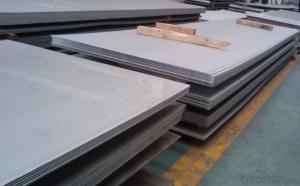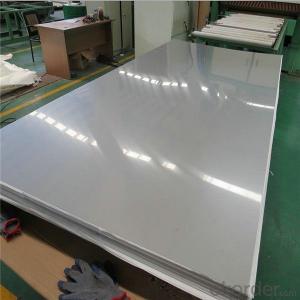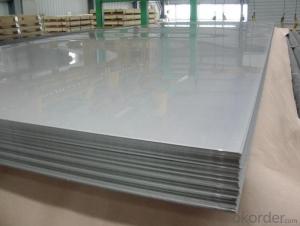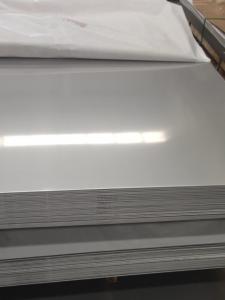304 201 316 bronze color Stainless Steel Sheet for decoration
- Loading Port:
- Shanghai
- Payment Terms:
- TT OR LC
- Min Order Qty:
- 2 m.t.
- Supply Capability:
- 20000 m.t./month
OKorder Service Pledge
OKorder Financial Service
You Might Also Like
Specification
304 201 316 bronze color stainless steel sheet size
1.Thickness: | 0.4~100mm |
2.Width: | 1000~2500mm |
3.Length: | 6000~8000mm or as your request |
3.Surface: | No.1, 2B, BA, 8K, etc. |
4.Standard: | ASTM, AISI, JIS, GB, DIN,EN, etc. |
5.Materia: | 201,202,304,304L,304J1, 316,316L,321,309S,310S,904L, 347;duplex |
6.Technique: | Cold Rolled or Hot Rolled |
7.Certification: | ISO |
8.Package: | Standard export packing or as your request |
9.Application: | Used in construction, chemical industry, electricity industry, food service industry, paper-making industry,and so on. |
10.Delivery Time: | Within 15 days |
11.Payment: | T/T, L/C,Western union |
If you are interested in any of our products or have other products you would like to import, please contact us with your requirements.
Main product chemical composition
Grade | C % | Si % | Mn % | P % | S % | Cr % | Mo % | Ni % | Other % |
201 | ≤0.15 | ≤1.00 | 5.5-7.5 | ≤0.06 | ≤0.03 | 16-18 | - | 3.5-5.5 | N≤0.25 |
202 | ≤0.15 | ≤1.00 | 7.5-10.0 | ≤0.06 | ≤0.03 | 17-19 | - | 4.0-6.0 | N≤0.25 |
301 | ≤0.15 | ≤1.00 | ≤2.00 | ≤0.045 | ≤0.03 | 16-18 | - | 6.0-8.0 | - |
302 | ≤0.15 | ≤1.00 | ≤2.00 | ≤0.045 | ≤0.03 | 17-19 | - | 8-10.0 | - |
303 | ≤0.15 | ≤1.00 | ≤2.00 | ≤0.2 | ≥0.015 | 17-19 | ≤0.6 | 8.0-10.0 | - |
304 | ≤0.08 | ≤1.00 | ≤2.00 | ≤0.045 | ≤0.03 | 18-20 | - | 8-10.5 | - |
304L | ≤0.03 | ≤1.00 | ≤2.00 | ≤0.045 | ≤0.03 | 18-20 | - | 9-13 | - |
309S | ≤0.08 | ≤1.00 | ≤2.00 | ≤0.045 | ≤0.03 | 22-24 | - | 12-15 | - |
310S | ≤0.08 | ≤1.5 | ≤2.00 | ≤0.045 | ≤0.03 | 24-26 | - | 19-22 | - |
316 | ≤0.08 | ≤1.00 | ≤2.00 | ≤0.045 | ≤0.03 | 16-18 | 2-3 | 10-14 | - |
316L | ≤0.03 | ≤1.00 | ≤2.00 | ≤0.045 | ≤0.03 | 16-18 | 2-3 | 12-15 | - |
317 | ≤0.08 | ≤1.00 | ≤2.00 | ≤0.045 | ≤0.03 | 18-20 | 3-4 | 11-15 | - |
321 | ≤0.08 | ≤1.00 | ≤2.00 | ≤0.045 | ≤0.03 | 17-19 | - | 9-13 | Ti≥5×C |
430 | ≤0.12 | ≤0.75 | ≤1.00 | ≤0.04 | ≤0.03 | 16-18 | - | ≤0.6 |


- Q: What's the difference between stainless steel 8K and BA?. How to distinguish from the surface of materials?
- Stainless steel surface grade is divided into 2B, BA, 4K, 8K... BA can take a blurry picture. 8K is the highest grade of stainless steel, like a mirror, instead of a mirror.
- Q: Are stainless steel sheets suitable for automotive applications?
- Yes, stainless steel sheets are suitable for automotive applications. They are widely used in the automotive industry due to their durability, corrosion resistance, and high strength-to-weight ratio. Stainless steel sheets provide excellent protection against rust and can withstand harsh conditions, making them ideal for various automotive components such as exhaust systems, body panels, and structural parts.
- Q: What is the maximum temperature stainless steel sheets can withstand?
- The specific grade of stainless steel determines the maximum temperature that stainless steel sheets can endure. Typically, most stainless steel grades can handle temperatures up to approximately 1500°F (815°C) without significant oxidation or scaling. Nevertheless, some high-temperature stainless steel grades like 310 or 321 can endure temperatures up to 2100°F (1150°C) or even higher. To guarantee optimal performance and durability, it is crucial to consider the specific application and grade of stainless steel when determining its maximum temperature resistance.
- Q: Who knows the production process of stainless steel plate?
- Stainless steel surface process:Stainless steel has a variety of surface processing to broaden its application areas, different surface processing makes the surface of stainless steel different, making it unique in the application.The corrosion environment requires smooth surface for smooth surface is not easy to fouling. Deposition of dirt can make stainless steel rusty and even cause corrosion.In the spacious lobby, stainless steel is the most commonly used decorative materials for the elevator decoration, although the surface of the fingerprint can erase, but affect the appearance, it is best to use the appropriate surface to prevent leaving fingerprints.
- Q: Inspection method for stainless steel welding
- The position of the welding is measured by hand, beat, shake, push and push. The sensing effect of the component is tested. The welding should be firm and reliable, and the strength of each component is required to meet the requirements of the strength of each component. Not false welding, weld and weld loose crack,
- Q: Are stainless steel sheets suitable for brewing equipment?
- Yes, stainless steel sheets are highly suitable for brewing equipment due to their durable, corrosion-resistant, and hygienic properties. Stainless steel is able to withstand the harsh conditions of the brewing process, including high temperatures and acidic environments, while preventing contamination and maintaining the quality of the beer. Additionally, stainless steel is easy to clean and maintain, making it a preferred material for brewing equipment.
- Q: How do stainless steel sheets compare to other materials like aluminum or carbon steel?
- Stainless steel sheets, when compared to other materials like aluminum or carbon steel, offer several distinct advantages that make them a preferred choice in various industries. 1. Corrosion Resistance: Stainless steel sheets are highly resistant to corrosion, making them suitable for applications where exposure to moisture or corrosive environments is common. Aluminum, while also corrosion-resistant, is not as durable as stainless steel in harsh conditions, and carbon steel is prone to rusting. 2. Strength and Durability: Stainless steel sheets are renowned for their strength and durability. They have a higher tensile strength than aluminum, making them more resistant to bending and deformation. Carbon steel has similar strength characteristics but is more susceptible to corrosion, especially in exposed applications. 3. Heat Resistance: Stainless steel sheets can withstand high temperatures without losing their structural integrity. They have excellent heat resistance properties, making them ideal for applications involving heat transfer or exposure to extreme temperatures. Aluminum, on the other hand, has lower heat resistance, while carbon steel can lose strength and become brittle at high temperatures. 4. Hygiene and Cleanliness: Stainless steel sheets are non-porous and easy to clean, making them a popular choice in industries where hygiene is critical, such as food processing or medical equipment. Aluminum and carbon steel, in comparison, may have more porous surfaces that can harbor bacteria or contaminants. 5. Aesthetics: Stainless steel sheets offer a sleek and modern appearance that is often desired in architectural and design applications. They can be easily polished or finished to achieve a variety of decorative effects. Aluminum and carbon steel sheets, while also versatile, may not provide the same level of aesthetic appeal. However, it's worth noting that stainless steel sheets can be more expensive than aluminum or carbon steel due to their superior properties. The choice of material ultimately depends on the specific requirements of the application, including factors such as cost, strength, corrosion resistance, and aesthetics.
- Q: Can stainless steel sheets be used for food processing equipment?
- Yes, stainless steel sheets can be used for food processing equipment. Stainless steel is a popular choice for such applications due to its corrosion resistance, easy cleaning properties, and hygienic characteristics. It is able to withstand high temperatures, is non-reactive with food, and does not impart any taste or odor.
- Q: Are stainless steel sheets good for chemical processing?
- Yes, stainless steel sheets are excellent for chemical processing. Stainless steel is known for its resistance to corrosion and chemical damage, making it a popular choice in various industries, including chemical processing. The high levels of chromium and nickel in stainless steel make it highly resistant to chemical reactions, even with harsh chemicals and acids. Additionally, stainless steel sheets are easy to clean, maintain, and sterilize, which is crucial in chemical processing environments where cleanliness and hygiene are paramount. The durability and strength of stainless steel sheets also ensure their longevity and ability to withstand high temperatures and pressure, making them suitable for a wide range of chemical processing applications. Overall, stainless steel sheets are a reliable and efficient choice for chemical processing due to their resistance to corrosion, ease of maintenance, and durability.
- Q: How do I determine the size and dimensions for stainless steel sheets?
- In order to ascertain the size and dimensions of stainless steel sheets, several factors need to be taken into account. Firstly, it is essential to consider the particular application or project for which the stainless steel sheets are required. By doing so, one can determine the necessary size and dimensions based on the sheets' purpose and function. Next, the specific dimensions in terms of length, width, and thickness should be considered. Typically, stainless steel sheets are available in standard sizes, so it is important to be aware of the required measurements in advance. Moreover, it is advisable to seek guidance and assistance from suppliers or manufacturers specialized in stainless steel sheets. These experts can help determine the appropriate size and dimensions based on the specific requirements. They may also have a variety of sizes readily available that can be customized to meet the needs. Furthermore, it is crucial to take into account any additional factors that might impact the size and dimensions of the stainless steel sheets. These factors include weight restrictions, installation requirements, and compatibility with other components or materials. In conclusion, careful consideration of the application, specific measurements, and consultation with industry experts is necessary to determine the size and dimensions for stainless steel sheets.
Send your message to us
304 201 316 bronze color Stainless Steel Sheet for decoration
- Loading Port:
- Shanghai
- Payment Terms:
- TT OR LC
- Min Order Qty:
- 2 m.t.
- Supply Capability:
- 20000 m.t./month
OKorder Service Pledge
OKorder Financial Service
Similar products
Hot products
Hot Searches
Related keywords
